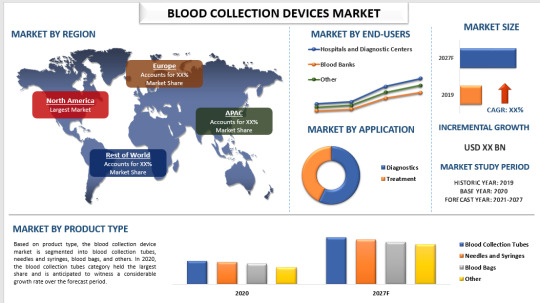#Blood-Collection-Devices-Market
Explore tagged Tumblr posts
Link
#market research future#venous blood collection#venous blood collection device#blood collection device market#venous blood size
0 notes
Link
#market research future#venous blood collection#venous blood collection device#blood collection device market#venous blood size
1 note
·
View note
Text
Blood Collection Devices Market will grow at highest pace owing to increase in number of blood donation procedures

Blood collection devices are medical instruments that are used for collecting blood samples from humans or animals in clinical settings. These devices make blood collection safer and easier for both healthcare professionals and patients. Devices such as needles, lancets, syringes, and blood collection tubes are key components used to draw blood samples. Continuous growth in number of blood donation procedures worldwide has augmented demand for blood collection devices. Increase in prevalence of blood disorders such as anemia, leukemia, and hemophilia is also fueling market growth. The demand for safe blood samples collection methods in diagnostic laboratories is further boosting adoption of blood collection devices. Rising healthcare expenditure in developing nations provides new opportunities to market players.
The Global Blood Collection Devices Market is estimated to be valued at US$ 9,244.72 Mn in 2024 and is expected to exhibit a CAGR of 6.1% over the forecast period 2023 to 2030. Key Takeaways Key players operating in the blood collection devices are Becton Dickinson and Co, Terumo Corp, Cardinal Health Inc, SARSTEDT AG & Co KG, Nipro Corp, Thermo Fisher Scientific Inc, Sekisui Chemical Co Ltd, Greiner Bio-One International GmbH, FL Medical SRL, and IntervacTechnology OU. These established players dominate the market owing to their robust product portfolio and global distribution network. The demand for blood collection devices is growing significantly owing increasing number of blood donations and rising prevalence of chronic diseases. As per WHO, around 122.6 million blood donations are collected globally each year from voluntary unpaid donors for helping patients in need of transfusion. Technological advancements in blood collection devices such as development of needle free collection methods, vacuum collection systems and automated blood collection systems are supporting market growth. These innovations aid in improving safety, efficacy and ease of blood sample collection procedures. Market Trends Growing preference for needle-free blood collection methods - Technological advancements have led to development of needle free blood collection systems such as lancet-integrated microfluidic system that can collect capillary blood samples in a minimally invasive way. This reduces pain and risk of injuries associated with traditional needles. Increasing demand for automated blood collection systems - Fully automated blood collection systems with features such as volume detection, needle retraction and sample labeling are gaining prominence. These automated solutions improve workflow efficiency of blood banks and diagnostic centers. Rising focus on personalized healthcare - Tailored diagnostics requiring specific blood biomarkers is generating need for new biomarkers assessment platforms that can analyze blood samples to deliver personalized healthcare programs and treatment decisions. This acts as a driver for high-tech blood collection devices. Market Opportunities Growing demand in developing markets - Emerging economies in Asia Pacific and Latin America with large patient pools and increasing healthcare spending present significant opportunities. Favorable regulatory environment and low manufacturing costs also attract players. Integration of IoT capabilities - Opportunities exist for players to develop "smart" blood collection devices integrated with Internet of Things (IoT) for applications such as real-time monitoring and predictive maintenance of blood storage equipment.
#Blood Collection Devices Market Growth#Blood Collection Devices Market Trend#Blood Collection Devices Market Share
0 notes
Text
Blood Collection Devices Market: Trends, Challenges, and Future Outlook
The blood collection devices market plays a crucial role in the healthcare sector, supporting diagnostic testing, transfusions, and research. This market encompasses a variety of devices, including needles, syringes, blood collection tubes, and lancets. With the rising prevalence of chronic diseases, increasing healthcare expenditures, and advancements in medical technology, the blood collection devices market is poised for significant growth. This article delves into the current trends, challenges, and future outlook of the blood collection devices market.

Current Market Trends
1. Technological Advancements
Innovations in blood collection technology are significantly enhancing the efficiency and safety of blood collection processes. Automated blood collection systems, for instance, minimize human error and improve the accuracy of blood sample volumes. Advanced materials and designs are also making blood collection devices more user-friendly and less painful for patients.
2. Increasing Prevalence of Chronic Diseases
The rising incidence of chronic diseases such as diabetes, cardiovascular diseases, and cancer is driving the demand for blood collection devices. Regular blood tests are essential for monitoring these conditions, thereby boosting the market for blood collection products.
3. Growing Awareness and Health Check-Up Programs
Increased awareness about the importance of regular health check-ups is leading to higher demand for diagnostic tests, which in turn fuels the need for blood collection devices. Government and private health check-up programs, especially in developing countries, are contributing to market growth.
4. Home Healthcare and Point-of-Care Testing
The trend towards home healthcare and point-of-care testing is gaining momentum, driven by the convenience and efficiency these options provide. Portable and easy-to-use blood collection devices are becoming popular for home use, enabling patients to perform routine tests without visiting healthcare facilities.
For a comprehensive analysis of the market drivers, visit https://univdatos.com/report/blood-collection-devices-market/
Challenges in the Market
1. Risk of Blood-Borne Infections
The risk of blood-borne infections remains a significant challenge in the blood collection process. Ensuring the safety and sterility of blood collection devices is paramount to prevent the transmission of infections. This requires stringent regulatory standards and compliance, which can be a hurdle for manufacturers.
2. High Cost of Advanced Devices
While technological advancements have improved the functionality of blood collection devices, they have also led to increased costs. High-end automated systems and advanced materials can be expensive, limiting their adoption in cost-sensitive markets.
3. Regulatory Compliance
The blood collection devices market is highly regulated, with stringent requirements for product approval and quality control. Navigating these regulatory landscapes can be complex and time-consuming for manufacturers, potentially delaying the launch of new products.
4. Shortage of Skilled Healthcare Professionals
The effective use of blood collection devices requires skilled healthcare professionals. A shortage of trained personnel, particularly in developing regions, can impede the efficient utilization of these devices and impact market growth.
Future Outlook
1. Expansion in Emerging Markets
Emerging markets present significant growth opportunities for the blood collection devices market. Increasing healthcare investments, improving healthcare infrastructure, and rising awareness about early disease diagnosis in countries like India, China, and Brazil are expected to drive market expansion.
2. Innovations in Device Design
Future developments in device design are likely to focus on improving patient comfort and ease of use. Innovations such as painless needles, micro-collection devices, and integrated data management systems are anticipated to revolutionize the blood collection process.
3. Integration with Digital Health Technologies
The integration of blood collection devices with digital health technologies will enhance the efficiency and accuracy of diagnostics. Devices equipped with IoT capabilities can automatically upload data to electronic health records (EHRs), facilitating real-time monitoring and analysis.
4. Sustainable and Eco-Friendly Products
As environmental concerns gain prominence, the development of sustainable and eco-friendly blood collection devices is expected to rise. Manufacturers are exploring biodegradable materials and reusable components to reduce the environmental impact of their products.
For a sample report, visit https://univdatos.com/get-a-free-sample-form-php/?product_id=22608
Conclusion
The blood collection devices market is set for substantial growth, driven by technological advancements, increasing prevalence of chronic diseases, and expanding healthcare access. While challenges such as regulatory compliance and high costs persist, the market's future looks promising with innovations in device design and integration with digital health technologies. By addressing these challenges and leveraging growth opportunities, the blood collection devices market can significantly enhance healthcare delivery and patient outcomes worldwide.
Contact Us:
UnivDatos Market Insights
Email - [email protected]
Contact Number - +1 9782263411x
Website -www.univdatos.com
#Blood Collection Devices Market#Blood Collection Devices Market Size#Blood Collection Devices Market Growth#Blood Collection Devices Market Forecast
0 notes
Text
Breaking Down Growth Patterns: Trends in the Arterial Blood Collection Devices Market
Market Overview –
According to forecasts, the arterial blood collection market would grow at a 10.2% annual rate from 2022 to 2030, or USD 1924.34 million.
The arterial blood collection market focuses on products and devices used to obtain blood samples from arteries for diagnostic testing, particularly for arterial blood gas (ABG) analysis. These tests measure the levels of oxygen, carbon dioxide, and other gases in the blood, providing critical information about a patient's respiratory and metabolic status.
Market growth is driven by the increasing prevalence of respiratory diseases, such as chronic obstructive pulmonary disease (COPD) and acute respiratory distress syndrome (ARDS), and the growing demand for point-of-care testing in emergency departments, intensive care units, and operating rooms. Arterial blood collection devices enable healthcare providers to quickly and accurately obtain blood samples for ABG analysis, facilitating timely diagnosis and treatment of respiratory and metabolic disorders.
Technological advancements and innovations in arterial blood collection devices are shaping the market, offering improved safety, ease of use, and sample quality. From prepackaged arterial blood gas syringes and safety lancets to integrated blood gas analyzers and wireless monitoring systems, these advancements enhance workflow efficiency and patient care in healthcare settings.
The Arterial Blood Collection Devices Market is witnessing substantial growth, primarily fueled by the rising demand for arterial blood collection syringes in healthcare settings. These devices are crucial for accurate blood gas analysis and are extensively used in critical care units and laboratories. Technological advancements and the increasing prevalence of chronic diseases are further driving market expansion.
Moreover, the COVID-19 pandemic has highlighted the importance of arterial blood gas analysis in managing respiratory complications and optimizing mechanical ventilation strategies in critically ill patients. Arterial blood collection devices play a crucial role in monitoring patients' oxygenation status, acid-base balance, and ventilation parameters, contributing to better patient outcomes and reduced mortality rates.
However, challenges such as blood sample variability, operator proficiency, and infection control concerns pose obstacles to market growth. Addressing these challenges requires collaboration between device manufacturers, healthcare providers, and regulatory agencies to develop standardized protocols, training programs, and quality assurance measures for arterial blood collection and analysis.
Overall, the arterial blood collection market presents significant opportunities for innovation and collaboration to improve patient care and outcomes in respiratory and critical care medicine. By investing in research, education, and technology, stakeholders can drive continued growth and advancement in the market and contribute to the development of more effective diagnostic and monitoring tools for patients worldwide.
Segmentation –
A wide range of blood collection devices are available for both venous and arterial blood collection purposes. Arterial blood collection involves obtaining blood samples from arteries to analyze arterial blood gases. The blood collection devices market is categorized into various types, including blood collection tubes, lancets, needles, vacuum blood collection systems, microfluidic systems, and other devices such as arterial cannulae and blood bags.
Arterial blood collection devices play a crucial role in diagnosing and treating diseases. They enable healthcare providers to conduct blood tests, aiding in disease diagnosis and treatment planning. These devices are utilized for arterial blood gas sampling and intraoperative blood salvage. The arterial blood collection market is further segmented based on application into arterial blood gas sampling, which includes disease diagnosis and acid-base status monitoring.
In terms of end users, the blood collection devices market includes hospitals and clinics, laboratories, blood banks, and other facilities like ambulatory surgery centers.
Regional Analysis –
Regional analysis of the Arterial Blood Collection Market provides crucial insights into the distribution and trends of blood collection methods for arterial sampling across diverse geographic regions. Understanding regional dynamics is essential for stakeholders to tailor their strategies effectively, considering factors such as the prevalence of cardiovascular diseases, healthcare infrastructure, and regulatory frameworks.
For instance, regions with a high prevalence of critical care admissions or cardiac surgeries may witness a heightened demand for arterial blood gas testing, thereby driving the adoption of arterial blood collection methods. Developed regions with advanced healthcare systems often have well-established protocols for arterial blood gas analysis, making arterial sampling a routine procedure in intensive care units and operating rooms. Conversely, developing regions may encounter challenges like limited access to arterial blood gas testing facilities, shortages of trained healthcare personnel, and financial constraints.
Factors such as government healthcare expenditure, reimbursement policies, and technological advancements significantly influence regional dynamics in the arterial blood collection market. Conducting a comprehensive regional analysis enables stakeholders to identify growth opportunities, assess competitive landscapes, and tailor strategies to address the specific needs of each region. Furthermore, understanding regional disparities in healthcare delivery and patient demographics facilitates the development of targeted interventions to improve access to arterial blood collection methods and enhance patient care outcomes. Overall, regional analysis serves as a vital tool for optimizing resource allocation, promoting innovation, and advancing healthcare quality in the arterial blood collection market.
Key Players –
The Arterial blood collection devices leading players include Becton, Dickinson and Company, Bio-Rad Laboratories, Inc., NIPRO Medical Corporation, QIAGEN, F. Hoffmann-La Roche Ltd, Terumo Medical Corporation, and Thermo Fisher Scientific, Inc.
Related Reports –
Medical Tourniquets
Forensic Swab
Ascites
Intraoperative Neurophysiological Monitoring
For more information visit at MarketResearchFuture
#Arterial Blood Collection Devices Market#Arterial Blood Collection Devices Market Size#Arterial Blood Collection Devices Market Share#Arterial Blood Collection Devices Market Trends
0 notes
Text
0 notes
Text
Capillary blood collection devices market is expected to gain market growth in the forecast period of 2022 to 2029. Data Bridge Market Research analyses the market to grow at a CAGR of 5.45% in the above-mentioned forecast period.
0 notes
Text
https://community.tccwpg.com/read-blog/198993
Capillary Blood Collection Devices Market report By Top Compnies Profiles, COVID-19 Impact, by Corporate Strategy Analysis 2030
0 notes
Text
The Best News of Last Week - March 27, 2023
🐢 - Why did the 90-year-old tortoise become a father? Because he finally came out of his shell!
1. New Mexico governor signs bill ending juvenile life sentences without parole

New Mexico Governor Michelle Lujan Grisham has signed a bill into law that prevents juvenile offenders from receiving life sentences without eligibility for parole. The bill, known as the No Life Sentences for Juveniles Act, allows offenders who committed crimes under the age of 18 and received life sentences to be eligible for parole hearings 15 to 25 years into their sentences.
This legislation also applies to juveniles found guilty of first-degree murder, even if they were tried as adults. The move puts New Mexico in a group of at least 24 other states and Washington, DC, that have enacted similar measures following a 2021 Supreme Court ruling.
2. Promising pill completely eliminates cancer in 18 leukaemia patients

An experimental pill called revumenib has shown promise in curing terminal leukemia patients who were not responding to treatment in a long-awaited clinical trial in the United States. The drug works by inhibiting a specific protein called menin, which is involved in the machinery that gets hijacked by leukemia cells and causes normal blood cells to turn into cancerous ones.
The pill targets the most common mutation in acute myeloid leukemia, a gene called NPM1, and a less common fusion called KMT2A. The US Food and Drug Administration granted revumenib "breakthrough therapy designation" to fast-track its development and regulatory review based on the promising results of the trial.
3. Spain passes law against domestic animal abuse

Spain has passed a new law on animal welfare, accompanied by a reform of the penal code that increases prison sentences for those mistreating animals. The law will make compulsory training for dog owners, and will prohibit them from leaving their dogs alone for more than 24 hours.
It also mandates the sterilisation of cats, with exceptions for farms, and increases the penalties for mistreatment of animals to up to two years in prison, or three years in the event of aggravating circumstances.
4. Bravery medals for women who raced into 'rough, crazy' surf to save drowning girls

Elyse Partridge (far left) and Bella Broadley (far right) raced into dangerous surf to save Chloe and Violet from drowning.(ABC North Coast: Hannah Ross)
Bella Broadley and Elyse Partridge saved two 11-year-old girls from drowning at Angels Beach near Ballina, an unpatrolled beach in Australia. The younger girls, Chloe and Violet, became trapped in a rip and overwhelmed by waves and the current. Bella and Elyse jumped into action, using an esky lid as a flotation device to help them swim to the girls. Elyse helped Chloe back to shore while Bella swam further out to help Violet.
Elyse and Bella were on Wednesday named on the Governor General's Australian Bravery Decorations Honours List, which recognised 66 Australians for acts of bravery.
5. Almost every cat featured in viral Tik Tok posted by Kansas City animal shelter adopted
Let's find homes for the rest
youtube
6. A 90-year-old tortoise named Mr. Pickles just became a father of 3. It's a big 'dill'

These critically endangered tortoises are native to Madagascar and have seen their numbers decline due to over-collection for illegal sales on the black market. Captive breeding programs have helped produce new radiated tortoises, but the species still faces extinction in the wild.
That's why the arrival of these hatchlings, born to 90-year-old Mr. Pickles and his 53-year-old partner Mrs. Pickles, is such great news. Mr. Pickles is considered the most genetically valuable radiated tortoise in the Association of Zoos and Aquariums' Species Survival Plan, and the births represent a significant contribution to the survival of the species.
7. EU strikes ‘ground-breaking’ deal to cut maritime emissions

The European Parliament and EU ministers have agreed on a new law to cut emissions in the maritime sector. The law aims to reduce ship emissions by 2% as of 2025 and 80% as of 2050, covering greenhouse gas, methane, and nitrous oxide emissions.
The European Commission will review the law in 2028 and will decide whether to place carbon-cutting requirements on smaller ships. The agreement will also require containerships and passenger ships docking at major EU ports to plug into the on-shore power supply as of 2030. Penalties collected from those that fail to meet the targets will be allocated to projects focused on decarbonising the maritime sector.
- - - -
That's it for this week :)
This newsletter will always be free. If you liked this post you can support me with a small kofi donation:
Buy me a coffee ❤️
Also don’t forget to share this post with your friends.
467 notes
·
View notes
Link
#market research future#venous blood collection#venous blood collection device#blood collection device market#venous blood size
0 notes
Text
Yandere!Prime Omega!Rin x Prime Alpha!Yoichi
Currently just sittin' here thinkin' 'bout Prime Omega Rin being completely and utterly consumed by his obsesssion with Prime Alpha Yoichi.
It's gross, and weird and decidedly concerning but Rin does not care in the slightest.
He's collected several of what he likes to call "keepsakes" from his encounters with the Alpha, like the classics: strands of hair (he once had the strong urge to clip off Yoichi's adorable little sprout while he slept and keep it), dirty undergarments (one time, when rifling through Yoichi’s dirty laundry hamper, Rin stumbled upon a pair of boxer-briefs stained with a small amount of precum. He nearly lost his mind at the scent, but before he could do anything to blow his cover, he pocketed the briefs and took them home to add to his "keepsake" collection), and little things that remind Rin of Yoichi, like that lobster keychain he caught him eyeing at a market one day.
But then, there's the stranger things Rin's somehow procured.
For instance, he's got several bandages seeped with Yoichi's blood that he keeps (that he may or may not have tried to suck the blood out of), a used toothbrush (which he may or may not have used himself), a very gently used razor, discarded gum and a worn bar of Yoichi’s favorite brand of soap.
Rin keeps everything hidden away and neatly organized in a space in his closet at home. He doesn't like to call it a shrine exactly, 'cus that's hella cliché, but that's lowkey kind of what it is.
He also has a ton of pictures of Yoichi, taken from various devices and saved in various places.
From candid captures to pictures with more of a professional setup, Rin adores seeing Yoichi in his natural state, whether that be in the midst of eating, sweating during training, or smiling big and bright.
Rin despises being away from Yoichi, he quite literally wants to cut him open and crawl up into his skin, then sew him back together from the inside out and just live curled up in his abdomen, closest to the Alpha's heart.
He's had increasingly violent thoughts about Yoichi, wanting to "devour" him, and be devoured in return.
He wants to be wrecked by Yoichi, used and hurt and ultimately consumed.
He wants to give him pups, a whole healthy litter- a big, happy family.
All these contrasting thoughts try their best to drive Rin insane. He tries his best to control them, but the task becomes more difficult as time passes, and he's forced to watch the friendly, sociable, magnetic, irresistible Yoichi laugh and interact with his friends and others.
Rin doesn't like the fact that other people take up so much of Yoichi's time. It makes the possessive, clingy, needy part of him flare up angrily.
Yoichi belongs to Rin. Whether he knows it yet or not.
Nothing's official; they've not yet given each other mating marks or even scented one another, but Rin knows in his heart of hearts that he and Yoichi are meant to be.
'My darling Alpha, I love you so much.'
#blue lock#bllk#omegaverse#itoshi rin#rin itoshi#isarin#omega!itoshi rin#omega!rin itoshi#isagi yoichi#yoichi isagi#rinsagi#blue lock omegaverse#bllk omegaverse#yandere#yandere blue lock#yandere bllk#yandere itoshi rin#yandere rin itoshi#yandere omegaverse
33 notes
·
View notes
Text
On May 7, 2011, Georgia resident Tonya Brand noticed a pain on the inside of her right thigh. As the pain grew worse in the 4- to 5-inch area of her leg, she headed to a hospital. There, doctors suspected she had a blood clot. But an ultrasound the next day failed to find one. Instead, it revealed a mysterious toothpick-sized object lodged in Brand's leg.
Over the next few weeks, the painful area became a bulge, and on June 17, Brand put pressure on it. Unexpectedly, the protrusion popped, and a 1.5-inch metal wire came poking out of her leg, piercing her skin.
The piece of metal was later determined to be part of a metal filter she had implanted in a vein in her abdomen more than two years earlier, in March 2009, according to a lawsuit Brand filed. The filter was initially placed in her inferior vena cava (IVC), the body's largest vein tasked with bringing deoxygenated blood from the lower body back up to the heart. The filter is intended to catch blood clots, preventing them from getting into the lungs, where they could cause a life-threatening pulmonary embolism. Brand got the IVC filter ahead of a spinal surgery she had in 2009, which could boost her risk of clots.
After the wire burst from her leg, X-rays showed that another metal shard had broken free from the filter and traveled. The second one lodged itself near her spine, which is where it remains—it's too risky to try to remove. Brand underwent surgery in July 2011 to try to remove the rest of the filter in her IVC, but the surgeons failed to collect the remnants after several attempts.
@startorrent02
10 notes
·
View notes
Text

or maybe y’all are just dipshits & don’t understand what tf you’re talking about
a) stop viewing social issues through the lens of your own self-actualization
boycotts aren’t about the consumer’s morality. they aren’t about being a “good” or “pure” person or “washing blood from your hands”. they aren’t about any kind of individualistic anything. they’re a tactic, pure and simple, that leverages market pressure against companies in order to convince that company to meet specific demands agreed upon by the collective that is performing the boycott—the point is improving collective conditions, not bolstering your individual moral superiority, and if you keep treating it like the latter rather than the former, you aren’t fighting for justice you’re just pushing other people down to serve your ego
people who are not members of groups that collectively agreed to perform a boycott may be invited to join the boycott but they are not obligated to participate in it. if being consistent with your personal convictions leads you to joining a protest or a boycott or other collective action, genuinely good on you. that has nothing to do with the “goodness” of the 8 billion other people on this planet who aren’t at your particular protest or who drink an occasional 16 ounces from the ever-growing list of companies you hate
if you’re thinking of typing a rebuttal, stop, and ask yourself what materials are in your phone, your laptop—whatever device you are reading this from—do you know where they all came from? where did the cobalt come from? do you know who assembled your device? do you know who picked the tomatoes in the food you eat? who made the clothes you wear? who slaughtered the cow or chicken in your sandwich? do you know how much were they paid? do you know what their working conditions are like? do you know what their countries’ governments are doing to people? congo, china, etc.
if someone is “complicit” in genocide for drinking a cup of coffee, how much more complicit are you in the same for the cobalt in your phone? for genocide, for slavery, for child labor
this world is built on blood and the same hands you use to type your self-righteous indignation have been smeared with it from the moment you first drew breath. stop striving for a more righteous lungful, stop beating people over the head about the “blood on their hands”, and just take steps to make the world a more livable place
b) starbucks has nothing to do with israel
they don’t even do business in israel. they don’t give money to the israeli government. they never posted “in support” of the israeli government or any violence against palestinians
in fact starbucks openly condemned violence against innocent gazans in the same statement that they condemned the october 7th massacre—a statement they only had to make in the first place because Starbucks Workers United’s october 7th “solidarity” post featured an image of the bulldozers Hamas used in the attack where they murdered more than a thousand people on a social media account bearing Starbucks’ name, and that is not something any reasonable person, organization, or company wants their name to associated with
starbucks does not “support” israel, much less “genocide”
there are other reasons to boycott starbucks, and godspeed to you if you do, but the idea that you’re a good or bad person (much less somehow stopping or contributing to genocide) for whether you buy a cup of fucking coffee is mind-numbingly asinine
33 notes
·
View notes